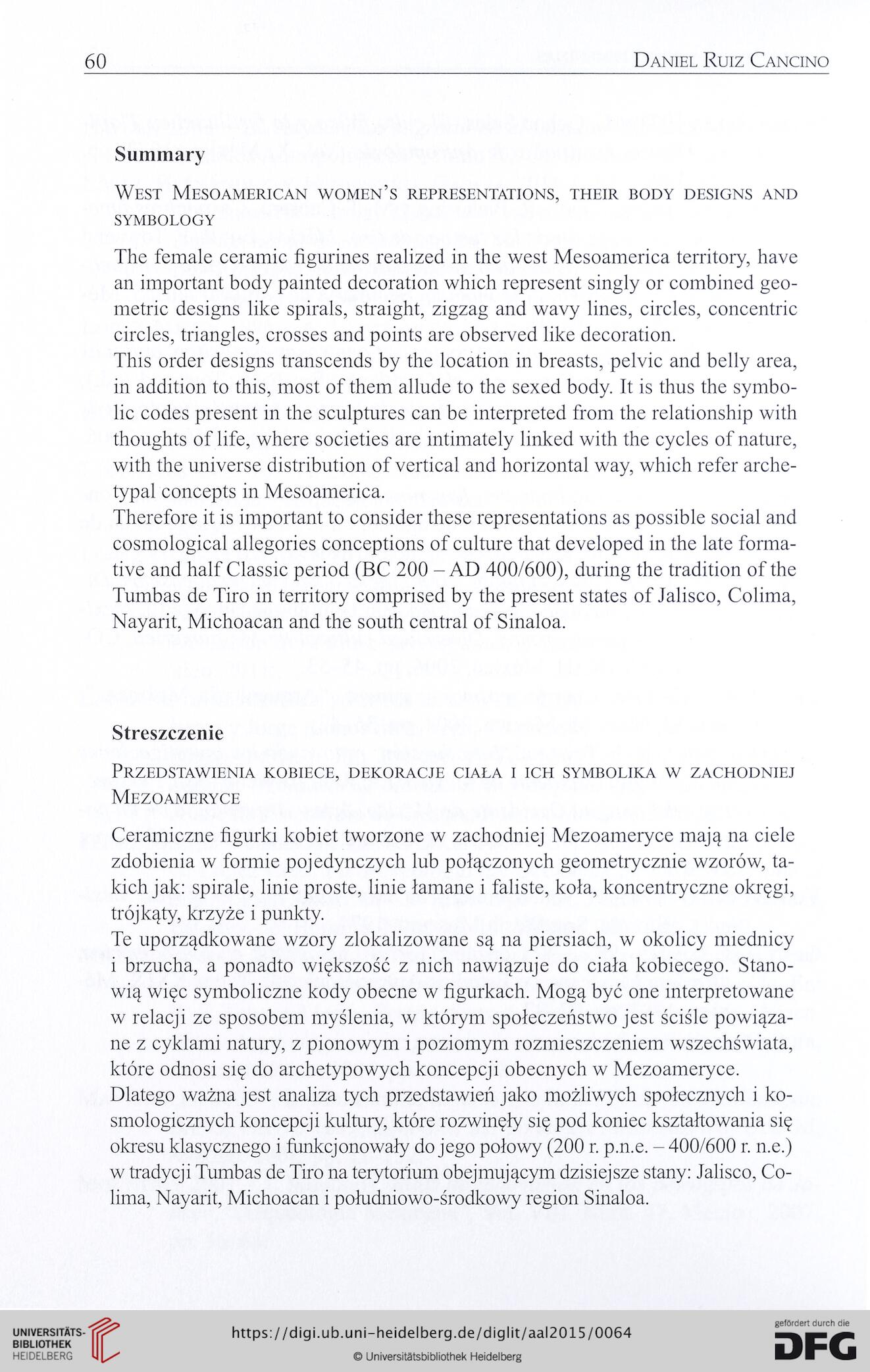60
Daniel Ruiz Cancino
Summary
West Mesoamerican women’s representations, their body designs and
SYMBOLOGY
The female ceramic figurines realized in the west Mesoamerica territory, have
an important body painted decoration which represent singly or combined geo-
metric designs like spirals, straight, zigzag and wavy lines, circles, concentric
circles, triangles, crosses and points are observed like decoration.
This order designs transcends by the location in breasts, pelvic and belly area,
in addition to this, most of them allude to the sexed body. It is thus the symbo-
lic codes present in the sculptures can be interpreted from the relationship with
thoughts of life, where societies are intimately linked with the cycles of nature,
with the universe distribution of vertical and horizontal way, which refer arche-
typal concepts in Mesoamerica.
Therefore it is important to consider these representations as possible social and
cosmological allegories conceptions of culture that developed in the late forma-
tive and half Classic period (BC 200 - AD 400/600), during the tradition of the
Tumbas de Tiro in territory comprised by the present states of Jalisco, Colima,
Nayarit, Michoacan and the south central of Sinaloa.
Streszczenie
Przedstawienia kobiece, dekoracje ciała i ich symbolika w zachodniej
Mezoameryce
Ceramiczne figurki kobiet tworzone w zachodniej Mezoameryce mają na ciele
zdobienia w formie pojedynczych lub połączonych geometrycznie wzorów, ta-
kich jak: spirale, linie proste, linie łamane i faliste, koła, koncentryczne okręgi,
trójkąty, krzyże i punkty.
Te uporządkowane wzory zlokalizowane są na piersiach, w okolicy miednicy
i brzucha, a ponadto większość z nich nawiązuje do ciała kobiecego. Stano-
wią więc symboliczne kody obecne w figurkach. Mogą być one interpretowane
w relacji ze sposobem myślenia, w którym społeczeństwo jest ściśle powiąza-
ne z cyklami natury, z pionowym i poziomym rozmieszczeniem wszechświata,
które odnosi się do archetypowych koncepcji obecnych w Mezoameryce.
Dlatego ważna jest analiza tych przedstawień jako możliwych społecznych i ko-
smologicznych koncepcji kultury, które rozwinęły się pod koniec kształtowania się
okresu klasycznego i funkcjonowały do jego połowy (200 r. p.n.e. - 400/600 r. n.e.)
w tradycji Tumbas de Tiro na terytorium obejmującym dzisiejsze stany: Jalisco, Co-
lima, Nayarit, Michoacan i południowo-środkowy region Sinaloa.
Daniel Ruiz Cancino
Summary
West Mesoamerican women’s representations, their body designs and
SYMBOLOGY
The female ceramic figurines realized in the west Mesoamerica territory, have
an important body painted decoration which represent singly or combined geo-
metric designs like spirals, straight, zigzag and wavy lines, circles, concentric
circles, triangles, crosses and points are observed like decoration.
This order designs transcends by the location in breasts, pelvic and belly area,
in addition to this, most of them allude to the sexed body. It is thus the symbo-
lic codes present in the sculptures can be interpreted from the relationship with
thoughts of life, where societies are intimately linked with the cycles of nature,
with the universe distribution of vertical and horizontal way, which refer arche-
typal concepts in Mesoamerica.
Therefore it is important to consider these representations as possible social and
cosmological allegories conceptions of culture that developed in the late forma-
tive and half Classic period (BC 200 - AD 400/600), during the tradition of the
Tumbas de Tiro in territory comprised by the present states of Jalisco, Colima,
Nayarit, Michoacan and the south central of Sinaloa.
Streszczenie
Przedstawienia kobiece, dekoracje ciała i ich symbolika w zachodniej
Mezoameryce
Ceramiczne figurki kobiet tworzone w zachodniej Mezoameryce mają na ciele
zdobienia w formie pojedynczych lub połączonych geometrycznie wzorów, ta-
kich jak: spirale, linie proste, linie łamane i faliste, koła, koncentryczne okręgi,
trójkąty, krzyże i punkty.
Te uporządkowane wzory zlokalizowane są na piersiach, w okolicy miednicy
i brzucha, a ponadto większość z nich nawiązuje do ciała kobiecego. Stano-
wią więc symboliczne kody obecne w figurkach. Mogą być one interpretowane
w relacji ze sposobem myślenia, w którym społeczeństwo jest ściśle powiąza-
ne z cyklami natury, z pionowym i poziomym rozmieszczeniem wszechświata,
które odnosi się do archetypowych koncepcji obecnych w Mezoameryce.
Dlatego ważna jest analiza tych przedstawień jako możliwych społecznych i ko-
smologicznych koncepcji kultury, które rozwinęły się pod koniec kształtowania się
okresu klasycznego i funkcjonowały do jego połowy (200 r. p.n.e. - 400/600 r. n.e.)
w tradycji Tumbas de Tiro na terytorium obejmującym dzisiejsze stany: Jalisco, Co-
lima, Nayarit, Michoacan i południowo-środkowy region Sinaloa.




